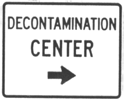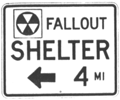Button, Button, Who's Got the Button?
Ukraine? Kazakhstan? In the wake of the recent Soviet Mess, these newly-formed republics have recently declared themselves "non-nuclear." Their associated strategic nuclear weapons are being moved to the Russian republic, in an effort to calm Western fears. At press time, we're still waiting on the other twelve republics, but does the simple relocation of missiles with locked targets make you feel any more comfy?
In the event that there is some type of nuclear missile exchange, you could probably do a lot better than our Civil Defense program, which consists of running around shouting "I thought I saw one of those yellow signs on a door in the courthouse." Wherever you may be located now, there's a good chance you may want to be Someplace Else when the bombs drop. I suggest taking your car; think of the problems airports have during Christmas, multiplied by say, infinity.
Hey, this one has melted tires! Uh ... I don't feel so good.
 Of course, anyone planning a mad dash across the nuclear-ravaged continent should be foremost concerned with the performance of their car. Will it survive a blast if ground zero is two miles away? A mile? The United States government has already pondered these queries in the form of numerous tests at Yucca Flats, Nevada, in 1953 ("Project Skyhook"). For each test, roughly fifty cars were scattered around a semi-circular target area. An atomic bomb was dropped from a small tower; then, a half-hour later, researchers checked the status of each car. The good news: you'll be able to drive your car if the hood doesn't collapse on you, or the steering wheel doesn't melt in your lap, or the whole thing doesn't go up in a fireball. We need more government tests like this, we really do; like a test of current models, and maybe park one of those new Chevy Caprice Classics ("The Space Lozenge 2000") at ground zero.
Of course, anyone planning a mad dash across the nuclear-ravaged continent should be foremost concerned with the performance of their car. Will it survive a blast if ground zero is two miles away? A mile? The United States government has already pondered these queries in the form of numerous tests at Yucca Flats, Nevada, in 1953 ("Project Skyhook"). For each test, roughly fifty cars were scattered around a semi-circular target area. An atomic bomb was dropped from a small tower; then, a half-hour later, researchers checked the status of each car. The good news: you'll be able to drive your car if the hood doesn't collapse on you, or the steering wheel doesn't melt in your lap, or the whole thing doesn't go up in a fireball. We need more government tests like this, we really do; like a test of current models, and maybe park one of those new Chevy Caprice Classics ("The Space Lozenge 2000") at ground zero.
Heavy glowing traffic on I-696
 A good objective of your post-nuclear journey would be to Drive To A Flat State That Has Only One Area Code: Montana, South Dakota, or Hawaii, for instance. During this time of crisis, however, the actual trip itself becomes a little more ... adventurous. In addition to the occasional distant mushroom cloud, war time drivers will be accosted by an array of new traffic conditions, laws, and signs. Most of these regulations are to keep vehicles from entering radiological zones, but one certain sign posted inside these zones heralds a new age of driving: the "Maintain Top Safe Speed" sign. One can almost feel two forces in brutal opposition: the need for responsible driving vs. the need to get the hell out of this glowing hole. Take your pick.
A good objective of your post-nuclear journey would be to Drive To A Flat State That Has Only One Area Code: Montana, South Dakota, or Hawaii, for instance. During this time of crisis, however, the actual trip itself becomes a little more ... adventurous. In addition to the occasional distant mushroom cloud, war time drivers will be accosted by an array of new traffic conditions, laws, and signs. Most of these regulations are to keep vehicles from entering radiological zones, but one certain sign posted inside these zones heralds a new age of driving: the "Maintain Top Safe Speed" sign. One can almost feel two forces in brutal opposition: the need for responsible driving vs. the need to get the hell out of this glowing hole. Take your pick.
Might as well change the oil while I'm down here
 Once you've woven your way through the morass that is Emergency Highway Traffic Regulation and found a good safe spot to hunker down, you're probably going to want a shelter to stay in. Hey, how about your car? Once again, Uncle Sam comes through for you, in the form of "Expedient Fallout Shelter #3: Car-Over-Trench." Dig a hole! Park over it! Fill your car with dirt! Crawl into the hole, and ... wait! According to the directions, "shelter can be constructed by two persons working a total of about eight hours each." I would think that time could be better put to use driving to a real shelter, unless, of course, you're in a Flat State That Has Only One Area Code and the closest building is in ... Indiana.
Once you've woven your way through the morass that is Emergency Highway Traffic Regulation and found a good safe spot to hunker down, you're probably going to want a shelter to stay in. Hey, how about your car? Once again, Uncle Sam comes through for you, in the form of "Expedient Fallout Shelter #3: Car-Over-Trench." Dig a hole! Park over it! Fill your car with dirt! Crawl into the hole, and ... wait! According to the directions, "shelter can be constructed by two persons working a total of about eight hours each." I would think that time could be better put to use driving to a real shelter, unless, of course, you're in a Flat State That Has Only One Area Code and the closest building is in ... Indiana.
All this is well and good, but I think I've figured out an easier way to avoid being totally obliterated by massive Soviet nuclear tonnage - see you later, comrade!
Intrigued? Curious? Paranoid? Ask for a copy of the FEMA Publications Catalog (FEMA-20) from: Federal Emergency Management Agency, P.O. Box 70274, Washington, DC 20024, ATTN: Publications.